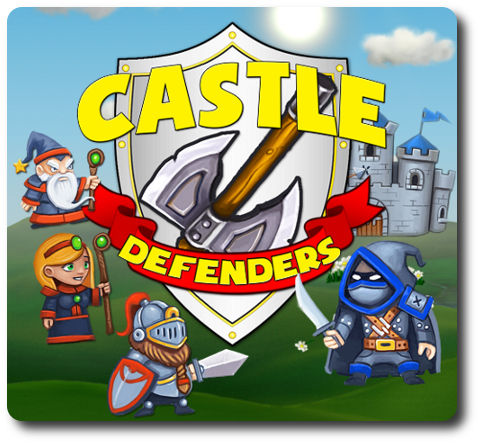
The Basics:
- For ages 7 and up (publisher suggests 12+)
- For 2 players
- Approximately 45 minutes to complete
Geek Skills:
- Counting & Math
- Logical & Critical Decision Making
- Reading
- Strategy & Tactics
- Risk vs. Reward
- Hand/Resource Management
- Worker Placement & Area Control
Learning Curve:
- Child – Easy
- Adult – Easy
Theme & Narrative:
- Defend your castle while destroying your enemy’s
Endorsements:
- Gamer Geek rejected!
- Parent Geek approved!
- Child Geek approved!
Overview
Chinese military general, strategist, and philosopher Sun Tzu said, “Invincibility lies in the defense; the possibility of victory in the attack.” Which is to say, if you are well defended, nothing can defeat you, but you will defeat nothing if you don’t attack. In this game, each side is well defended and armed, but only the most tactical player on the battlefield will win the game. No guts, no glory.
Castle Defenders, designed by Daniel Zaccaro and published by Tiger Spy Games through the Game Crafter, is comprised of 34 Player cards (17 cards per player), 10 Unit cards (5 per player), 4 Castle cards (2 per player), 20 Treasure cards, 8 game board tiles (double-sided), 14 stands (7 each in 2 different colors), 24 small clips, and 1 standard six-sided die. The cards are as thick as your standard playing card and the game board tiles are made of thick cardboard. The illustrations by Krzysztof Dycha portray the fantasy units in a very stylized way, with big eyes and somewhat exaggerated features.
Getting Ready to Defend (and Attack) the Castle
Note: The Unit and Castle cards sit in a matching colored blue or red stand that holds the card upright on the game board. Essentially making each card a moving character on the battlefield. Inserting the Unit and Castle cards is necessary at the start of every game. Damage is kept track of by using a small clip that attaches to the sides of the card, where the clip’s point indicates the amount of damage the card has taken.
To set up the game, first shuffle the Treasure deck and have each player shuffle their own Player deck. Each player draws 4 cards from their Player deck and 2 cards from the Treasure deck. These cards should be kept hidden from their opponent until played. Each player places their Player deck in front of them and the Treasure deck is placed to one side of the game playing area.
Second, both players should agree upon an initial layout of the battleground, placing the game board tiles so the battleground is equal for both players. Two example layouts are provided with the game’s rules, but players are encouraged to come up with their own. Once the game board tiles are placed, the Castle cards are placed. If using one of the predefined layouts, the spot where the Castle card is placed is indicated on the illustration. If using a custom battleground, players should place their Castle cards at an equal distance from one another.
Third, each player places their Unit cards off to one side of the playing area. The initial damage value for each Unit card should be set to the default value of “0” (zero).
That’s it for game set up. Determine who the first player will be and defend your castle.
Castle Combat
Note: In order to keep the game balanced, the player to go second receives 1 bonus action and draws 1 extra card from their Player deck at the end of their turn. This bonus is only given on the second player’s first turn. After that, both players use the same rules.
Castle Defenders is played in turns with no set number of turns per game. On a player’s turn, they can perform up to 4 actions and any number of free actions. The various actions are summarized here. When a player discards a card, it goes face-up in the appropriate discard pile. A player can always look through their Player deck discard pile.
Play One Card
Cards fall into basically 3 different types. These are Units, Permanents, and One-Shots.
Units
The “Unit” Player cards allow the player to bring a Unit card into play at the cost of 1 action. The “Unit” Player card is discarded and the matching Unit card is deployed to any open Entrance space on the game board. This Unit card can be used immediately. All Unit cards start at maximum health.
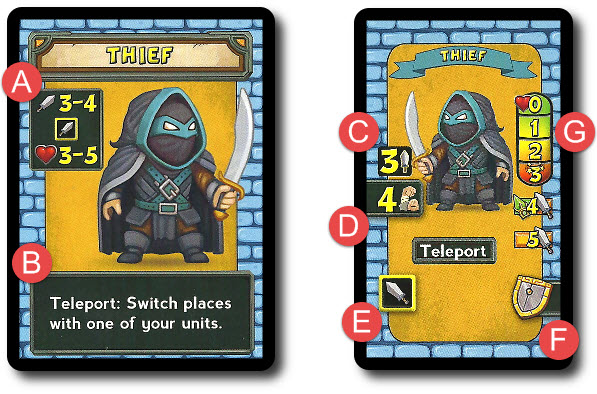
“Unit” Player card on the left and the matching Unit card on the right
A) The damage type, damage range, and Health range for the Unit
B) The Unit’s special ability
C) Normal Damage value and Damage Type
D) Upgraded Damage value
E) Attack Range and Damage Type
F) Armor Bonus (equipped armor goes here)
G) Unit Health
Permanents
The “Permanent” Player cards permanently alter a Unit card at the cost of 1 action. A Unit card can have their attack and defense values increased, making them all the more dangerous. A small clip is attached to the Unit card, indicating the new bonus attack or defense values.
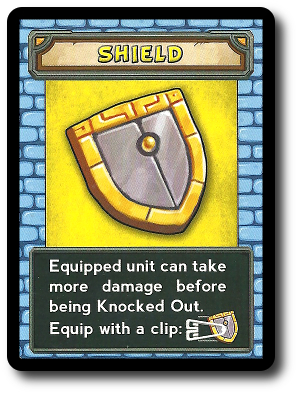
One-Shots
The “One-Shot” Player cards grant a special effect. Examples include casting spells, messing with an opponent’s hand of cards, and unleashing a strong attack. These cards are referred to as “One-Shots” because they are discarded as soon as they are used and their effects are immediately resolved. Most, but not all, “One-Shot” Player and Treasure cards will cost an action to play. Some have a lighting bolt symbol which indicates that playing the card is a free action. In which case, a player can play as many “One-Shot” cards on their turn as long as the total number of actions used does not exceed 4.
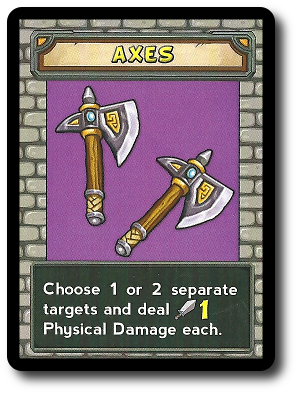
Attacking and Blocking
Deployed Unit cards can attack the opponent’s deployed Unit cards at the cost of 1 action. Each Unit card has their strengths and their weaknesses, meaning the player needs to recognize how best to confront their enemy and not accidentally walk into a fight they cannot win.
The Unit card will list a Normal Attack value and an Upgraded Attack value. Obviously, the Normal Attack value is used most of the time and then replaced by the Upgraded Attack value when that specific Unit has been boosted. Attacks also come in two types. These are physical or magical. Both are treated the same except in those instances where armor is involved.
On each Unit card are little squares that show a weapon. For each square, the Unit card can attack that many square spaces around them. Essentially, this is the Unit’s attack range. Some squares have an “X” which means the Unit cannot attack at the range indicated. Range is always counted using adjacent square spaces, never diagonal spaces. To determine if the target is in range, the player “walks” the attack by counting out square spaces, starting from the space the Unit card is currently occupying. However, attacks cannot pass through one enemy to another. The first target that is in the line-of-sight (a straight line from the attacking Unit) is going to get hit.
There are three exceptions, however. Healing, direct diagonal attacks, KO’ed Units, and attacks through friendly Units are not blocked.
When a Unit is successfully hit, damage is recorded by lowering the Unit’s current Health value. The amount of damage inflicted can be reduced by equipping Shields and standing on Armor spaces on the game board. If the Health value for a Unit drops to zero, the Unit is Knocked Out (KO’ed). The Unit is immediately placed face-down, but is not removed from the game. The player who owns the KO’ed Unit has 1 turn to revive it using the “Healer” Unit’s ability or using a Health Potion. If the Unit is revived, it keeps all of its equipment and comes back into the fight with 1 Health. If the KO’ed Unit is not revived in 1 turn, it’s “Banished”, which is a nice way of saying the Unit is dead. The Unit card is removed from the game board and the player who banished the Unit is rewarded by drawing 1 Treasure card.
Attacking the Castle is the same as attacking a Unit. The Castle must be in range to get hit, but has no way of blocking the damage dealt. Which is not really a problem, as a Castle can take a lot of damage.
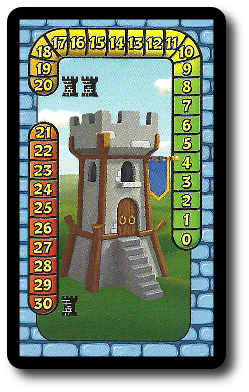
Swap Cards
Once per turn and at the cost of 1 action, the player can swap any number of cards out of their hand for new cards from their deck. This is done by placing the cards to be swapped out to one side, drawing the same number of cards from the Player deck, and then shuffling in the removed cards back into the Player deck. Players can never swap Treasure cards.
Move
All Units move up to 2 spaces on the game board. Movement is like a “jump”. The number of spaces moved ignores every space between the starting space and the end of movement space. Any spaces and things in those spaces between the starting and ending point are ignored. This includes other Units and even Castles. Diagonal movement is forbidden.
Movement can never end on an enemy Unit, enemy Castle, or enemy Entrance space. There are a few spaces that provide bonuses if the player ends their movement on them with a Unit. They are as follows.
- Tunnel: Unit can move to another Tunnel space.
- Armor: Any Unit in this space reduces physical damage taken by -1. This defense is added to any other defense bonus the Unit might have.
- Siege: Any Unit in this space increases physical and magical damage dealt by +1 for themselves and all other friendly Units, but only when attacking an enemy Castle. If more than one Siege space is occupied, multiple bonuses are applied.
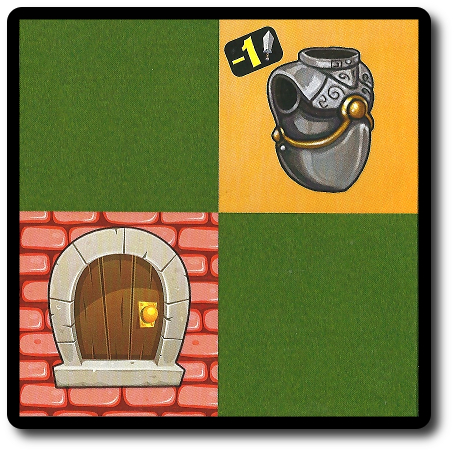
Entrance and Armor spaces shown
After the player has taken all their actions or elects to end their turn before doing so, they draw 2 cards from their Player deck and add them to their hand. It’s now the next player’s turn.
Crashing the Castle
The game continues until one player has removed all of their opponent’s Units or Castles currently occupying the game board. This player is the winner and controls the field. Well done!
Game Variant
Castle Defenders can only be played with 2 players. By adding a second copy of the game, an 8 x 8 game board can be built and the game can be played between teams of 2 players each. Teams alternate their turns, with the players on the same team working out the best strategy and tactics to destroy their opponents.
To learn more about Castle Defenders, visit the game’s web page.
Final Word
The Child Geeks had a blast with Castle Defenders. According to one Child Geek, “This game is so easy to learn and so hard to win! I keep losing my castle!” Another Child Geek said, “What you really have to watch in this game is how your opponents is moving. You can’t let them surround you or your dead.” All the Child Geeks, whether they knew it or not, were demonstrating good tactical plays by maneuvering their Units to key spots to maximize their damage output. The easy math made turns quick and the only time Child Geeks slowed down is when they came to a crossroads while making decisions with their cards. This was especially true when the Child Geek had a lot of Treasure cards to consider. When all the games were over, the Child Geeks fully approved Castle Defenders.

Two Child Geeks battle it out while I make dinner
The Parent Geeks were a little concerned when I told them that Castle Defenders was a light Wargame. They did not associate the word “light” with “war” and had some serious reservations about putting such a game in front of their kids, let alone their friends. After seeing the game and being instructed on how it was played, they were much less hesitant. According to one Parent Geek, “I thought this game was going to be much bigger and much more complicated, but it’s actually very easy to understand.” Another Parent Geek said, “This is not only a game I would play with my friends, but with my kids, too.” The only aspect of the game the Parent Geeks didn’t like was how few players could enjoy it at once. When I told them they could buy another copy and play as teams, that made a few Parent Geeks roll their eyes. As one Parent Geek put it, “Oh, sure. I get it. Want to play the game with more people? Buy more games. Pretty sneaky and a bit cheap, if you ask me.” Regardless of how the Parent Geek did or did not feel about the game’s marketing direction, all the Parent Geeks approved the game.
The Gamer Geeks found Castle Defenders to be an excellent example of how a Wargame should be designed for new players. According to one Gamer Geek, “This is done exactly right. Emphasis is on position and the math is kept to a minimum. The player can focus on what they are doing and get immediate feedback, adjusting their tactical approach as needed. A nicely designed game.” But it was also the game’s design that caused a number of Gamer Geeks to dislike it. According to one of these Gamer Geeks, “The game is way too easy. Very simple strategy, a handful of tactical decisions, and not nearly enough ways to maneuver. A neat game for new players, maybe, but not for me.” And that’s when the Gamer Geeks started to fight among themselves. There were a few who thought the game should be approved because it was easy to learn and provided tactical game play. The majority felt the game should be rejected since it lacked depth, was more or less a game of movement, and combat was heavily influenced by random cards. In the end, the majority of Gamer Geeks voted to reject Castle Defenders.
Castle Defenders is a fantastic way to introduce young and non-gamer players to the wonderful world of miniature based Wargames. Miniatures are a lot of fun to look at, but I’ve heard it said time and time again that they are also intimidating. How can a little piece of plastic be intimidating, you ask? Simply put, it’s not. It’s the game system and complex rules around the little miniature that lead inexperienced players to believe that the game will be complicated. Here’s a good example. What if BattleTech was played not with miniatures and small-scale models, but with a simple square grid and cards to represent the different mechs? Of course the game would be simpler, but it would also appear to be much more approachable. Castle Defenders is doing just that. It’s the colorful, cartoonish characters and its small game playing space that makes it easy to approach. It’s only after you start playing do you understand you are not playing a simple game.
Castle Defenders might not be simple to win, but it’s most certainly easy to learn. There really isn’t much for a player to do and that means there isn’t a lot for a player to think about. The hardest part of this game is attempting to anticipate your opponent’s moves and positioning your Units to survive longer than your opponent’s. Castle Defenders is really a game about positioning, rather than brutal attacks. The emphasis is on tactics since the only strategy is to either banish your opponent’s Units or wreck their castle. How you go about doing that is where the fun is and where the cards come into play. Lots of different ways to mess with your opponent, but the results are always damage related or hinder movement. Little else. Still the cards the players can use are fun and have real impact to the game play, making each worth considering and meaningful.
Like the Gamer Geeks, I loved the game’s simple concept and complete lack of luck. A player won the game either by being a better tactician or by being matched with an inexperienced opponent. And like the Gamer Geeks, that’s where my love for the game ends. There just isn’t enough in the game to keep me interested for very long and lack of indepth strategic game play meant the game felt fairly shallow, despite the fun tactical game play it provided.
As a Parent Geek, I loved Castle Defenders. It’s fast, easy to set up, and best of all, easy to teach. All of our Child Geeks were up and defending their castles within about 10 minutes of explaining the game. Within 20 minutes, they were totally focused on the game and loving it. It’s hard to get Wargames to the table due to the sharp learning curve. Castle Defenders has a learning curve so newbie friendly, you’ll wonder why the game isn’t on everyone’s game shelf.
The only other aspect of the game worth mentioning is the game components. Use of cards to represent Units, Castles, and other equipment is super good. Attaching a clip to the cards that is moved around, removed, and slid up and down is a horrible idea. It damages the cards quickly and suddenly your game doesn’t look that good. Then your cards get dented to a point where they start to rip. Pretty soon your Units and Castles look like they really took battle damage. If the game is ever re-released, I hope the game components get an upgrade. Art and game play is solid, but the current method of using clips should be abandoned as soon as possible.
Overall, neat game. Nothing terribly new here for those who have played Wargames before, but that’s not necessarily a bad thing. Castle Defenders has simple rules which makes it easy to play and easy to teach. Young and inexperienced players had no problem learning how to play and then kicking butt. While the game did not tantalize the gaming elitists, it conquered the hearts of everyone else. If Castle Defenders sounds like a game you’d like to play, do give it a try.
This game was given to Father Geek as a review copy. Father Geek was not paid, bribed, wined, dined, or threatened in vain hopes of influencing this review. Such is the statuesque and legendary integrity of Father Geek.



